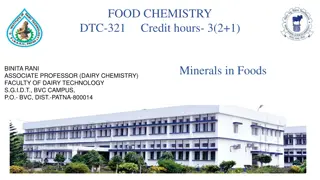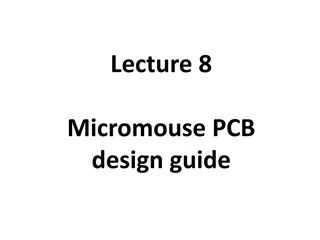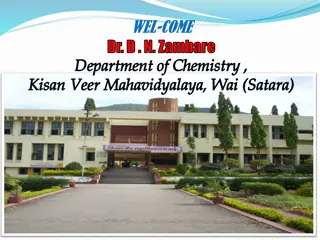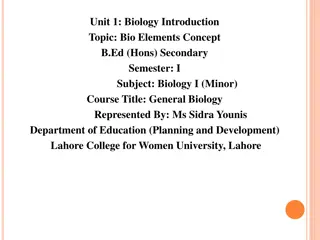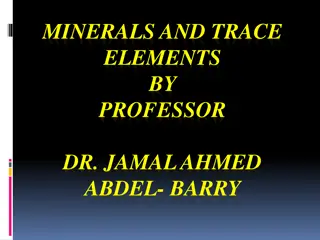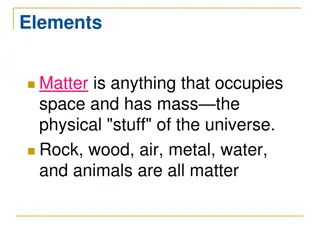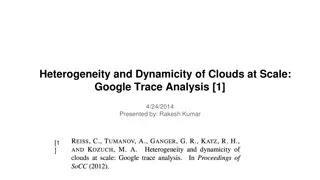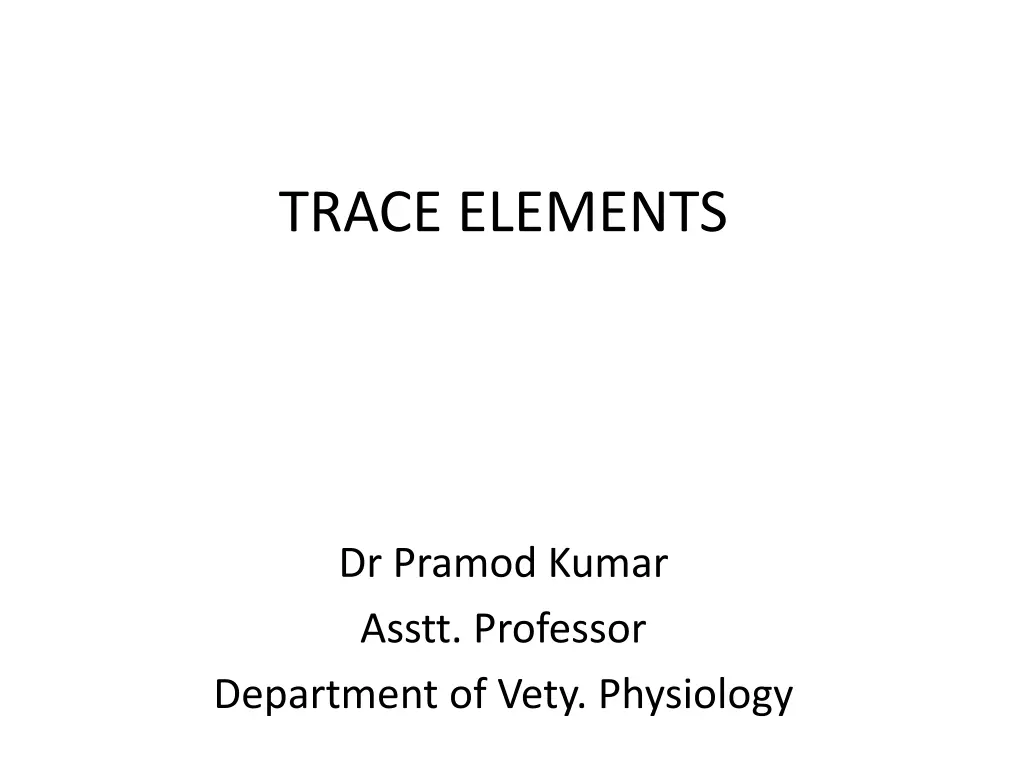
Understanding the Importance of Trace Elements in Animal Physiology
Discover the essential role of trace elements like iron, zinc, copper, and more in animal metabolism and physiological functions. Learn how these minerals impact growth, development, and metabolic regulation, ensuring optimal health and balance within the body.
Download Presentation

Please find below an Image/Link to download the presentation.
The content on the website is provided AS IS for your information and personal use only. It may not be sold, licensed, or shared on other websites without obtaining consent from the author. If you encounter any issues during the download, it is possible that the publisher has removed the file from their server.
You are allowed to download the files provided on this website for personal or commercial use, subject to the condition that they are used lawfully. All files are the property of their respective owners.
The content on the website is provided AS IS for your information and personal use only. It may not be sold, licensed, or shared on other websites without obtaining consent from the author.
E N D
Presentation Transcript
TRACE ELEMENTS Dr Pramod Kumar Asstt. Professor Department of Vety. Physiology
INTRODUCTION The trace elements serve a variety of functions including catalytic, structural and regulatory activities in which macromolecules such as enzymes, pro-hormones, pre-secretory granules and biological membranes. they interact with
Essential optimum metabolic function in an animal`s body. Iron Zinc Copper Manganese Iodine Chromium Selenium Molybdenum cobalt trace elements are required for
Characterization on metabolic activities Anions Cations Maintains homeostasis by different pathways. Anions absorbed easily and homeostasis is mediated by renal excretion. Cations need specific pathways for absorption and their homeostasis is effected by gastrointestinal and biliary secretion.
Anions - negatively charged ion or electrolytes. Extracellular anions are chloride, bicarbonate, phosphate, sulfate, protein and organic acids. Intracellular anions are chloride, bicarbonate, phosphate and protein. Cations - positively charged ion or electrolyte. Extracellular cations are sodium, potassium, calcium and magnesium. Intracellular cations are potassium, magnesium.
Minerals - inorganic regulators needed for different functions inside the body. Regulates: provision of energy protoplasmic activities body fluid balance acid-base balance structural units of bones, teeth, haemoglobin and thyroxin
Physiological functions growth and development functioning of the body; iodine in thyroxin, zinc in insulin, Cobalt in Vitamin B12, sulphur in thiamine and iron in hemoglobin. In tissue protein, cell bodies and muscles - responsible for their proper functioning.
Metabolic regulation Metalloenzymes such as the cytochrome enzymes facilitate ATP production Zinc and copper acts as natural antioxidant enzymes Influence to the osmotic pressure of body fluids as Na and K salts maintenance of acid base balance by preventing accumulation of too much acid or alkali.
Classification of Minerals Microminerals @ less than 100mg/day Macrominerals @ 100mg/day Ca, K and Na maintain the heart beat rhythm. Ca maintains normal response to nerve stimulus Ca is responsible for clot formation.
Sodium Regulates ATP-dependent channels with potassium for the transmission of nerve impulses in the brain. Blood level controlled by aldosterone, ANP and ADH. Excessive sodium can cause hypernatraemia Low sodium levels can cause hyponatraemia
Potassium major intracellular cation key circulating electrolyte Regulates ATP-dependent channels along with sodium in a 3:2 ratio to maintain the difference in K content between ECF and ICF Maintains osmotic pressure Maintains water balance
Contd.. Maintains acid-base balance Acts as co-factor for several glycolytic enzymes Transmit nerve impulses Maintains activity and synthesis of nuclear and proteins Hyperkalameia - increase serum K in the plasma Hypokalameia - decrease serum K level in the plasma
Chlorine regulate water balance (osmotic pressure and acid base) nerve impulse conduction hydrochloric acid formation in the stomach Change in plasma level might cause abnormal metabolism of Na+ & Cl lead to hyperchloraemia or hypochloremia
Calcium Intracellular calcium: muscle contraction releases hormones (neuro-transmitter/modulators) activation of some enzyme enter in glycogen metabolism cell division
Contd Extracellular calcium: maintain ECF calcium concentration bone mineralization blood coagulation membrane excitability muscle contraction
Phosphorous synthesis of nucleic acids synthesis of ATP maintenance of pH balance act as major buffer system (phosphoric acid) part of DNA and RNA and necessary for growth Activates many enzymes and vitamins B ATP uses three phosphate groups
Magnesium active in many enzyme systems resides half the body s magnesium in the bones rest is in muscles and soft tissues 1 % in the extracellular fluid calcium, bone magnesium may serve as a reservoir to ensure normal blood concentrations. necessary for energy metabolism catalyst in the reaction to form ATP compound permit the use of glucose involved in the synthesis of protein, fat and nucleic acids Involved in cells membrane transport systems.
Calcium and magnesium is involved in muscle contraction and blood clotting calcium promotes whereas magnesium inhibits interaction between the two mineral helps to regulate blood pressure and lung function supports the normal functioning of the immune system
Chromium It is needed in small amount for certain biological function control of glucose metabolism lipid metabolism acts as cofactor for increasing glucose utilization transport amino acids into cells lower cholesterol level
Manganese involved in protein and fat metabolism promotes healthy nervous system necessary for digestive function, bone growth, and immune function necessary for the proper function of SOD
Copper involved in the formation of red bloods cells involve in oxidation reduction reactions involved in the proper processing of collagen for production of skin, bone, and connective tissue
Iodine required for the synthesis of T3 and T4 deficiency leads to cretinism and goiter Cretinism;- deficiency during pregnancy lead to neonatal hypothyrodism characterized by mental retardation, dwarfism and retarded development Goiter characterized by enlargement of thyroid gland and impairment of thyroxin production
Iron synthesisze haemoglobin, myoglobin, chytochromes, catalase and peroxidase stored in the body as ferritin or haemosiderin Ferritin is iron storage compound in liver, spleen and bone The protein compound of ferritin is apoferritin Deficiency leads to result in hypochromic microcytic anaemia
Selenium constituent of glutathione peroxidase protects the cell membrane against oxidative damage by H2O2 prevents lipid oxidation and protect cell against superoxide free radicals
Zinc acts as co-factor for enzymes involved in variety of biochemical processes interacts with insulin to ensure proper function regulates blood glucose levels promotes wound healing regulates immune function serves as co-factor for numerous antioxidant enzymes necessary for protein synthesis processing of collagen
Sulfur consists essential amino acids for skin, hair, nails, liver and pancreas primary function in amino acid metabolism modified complex carbohydrates present in proteins and lipids amino acid methionine is the source cofactors or regulators of enzyme function

